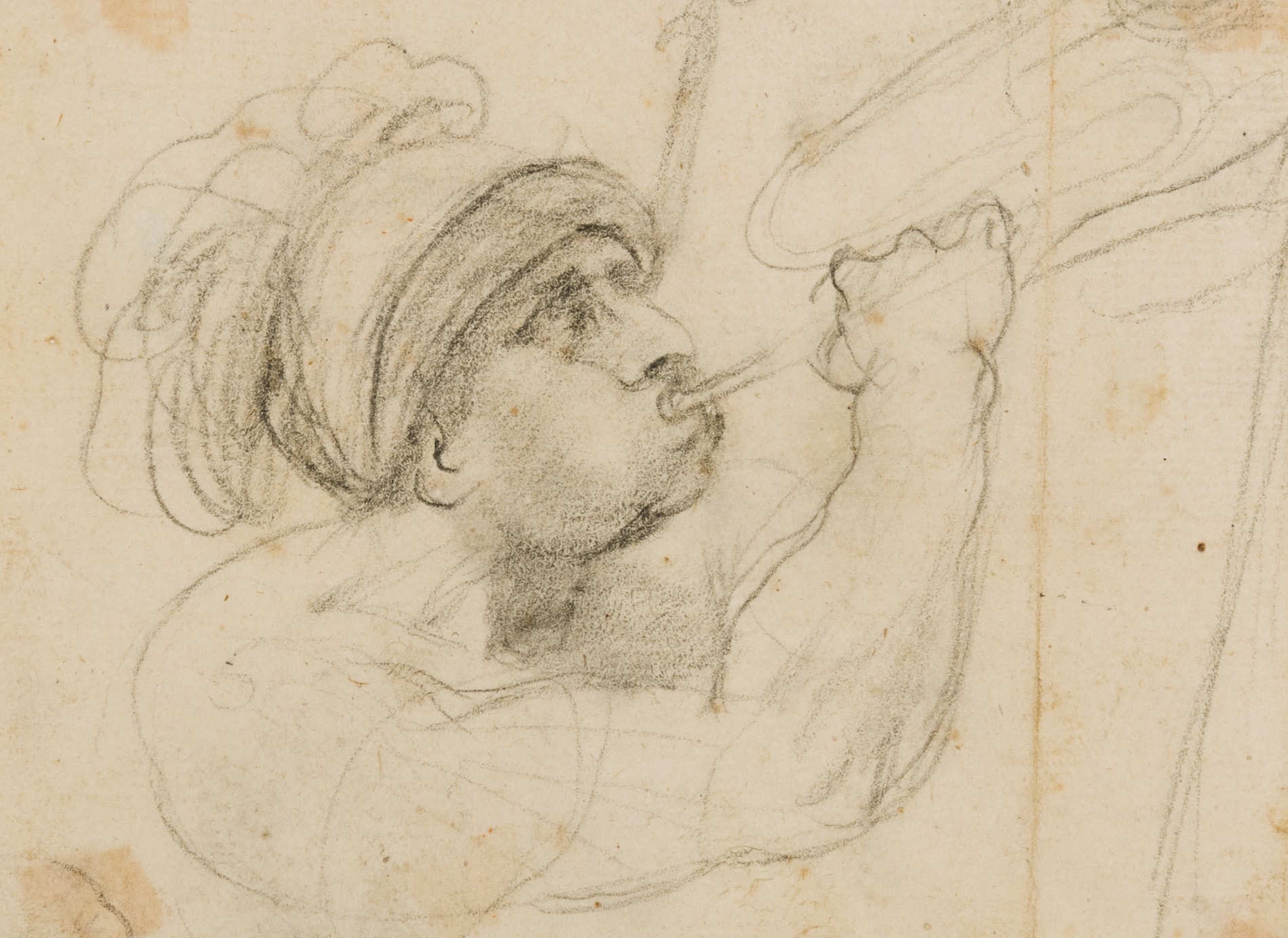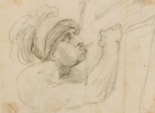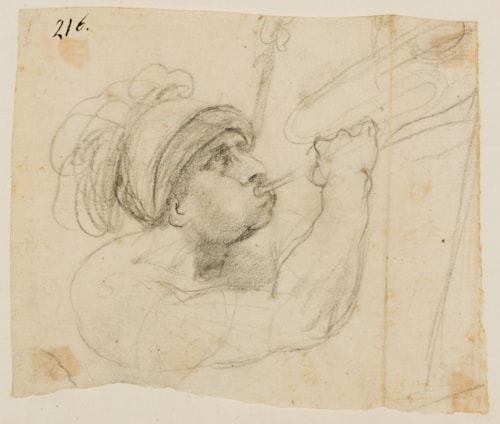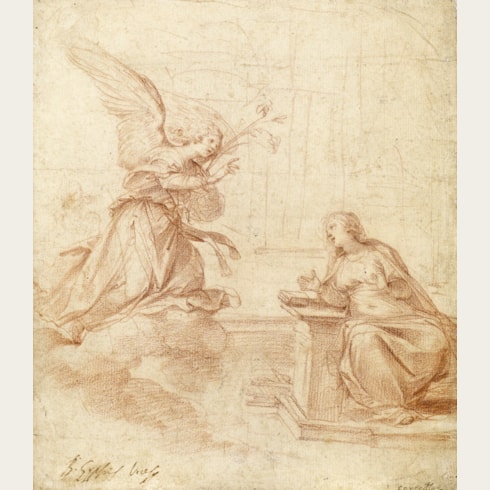Giuseppe Cesari CAVALIERE D'ARPINO
(Arpino 1568 - Rome 1640)
A Soldier Blowing a Trumpet
Sold
Black chalk.
Numbered 216. in brown ink at the upper left.
100 x 123 mm. (3 7/8 x 4 7/8 in.)
Numbered 216. in brown ink at the upper left.
100 x 123 mm. (3 7/8 x 4 7/8 in.)
Datable to around 1597, this small drawing would seem to be a study for the trumpeter that appears in the left background of Cavaliere d'Arpino’s monumental fresco of The Battle Between the Romans, led by Tullus Hostilius, and the Veientes and the Fidenates in the Palazzo dei Conservatori in Rome, painted between 1597 and 1601. The fresco, which measures 10 x 14 metres, is one of Arpino’s most significant works, and a number of preparatory chalk drawings by the artist survive for various figures, heads and horses in the composition, as well as two large-scale compositional oil sketches on canvas. Other drawings by Arpino for the same fresco, executed in both red and black chalk, are today in the collections of the Kupferstichkabinett in Berlin, the Museum Kunst Palast in Düsseldorf, the Uffizi in Florence, the Metropolitan Museum of Art in New York, the Louvre in Paris, and elsewhere.
The present sheet was part of an album of miscellaneous drawings, mainly by Italian artists of the late 16th century, which appeared at auction in London in 1980, when the drawings were dispersed. Apparently compiled sometime in the 17th century, the album was made up predominantly of studies of heads, with the drawings each numbered in black ink, from 2 to 272. Although the album included single drawings by Federico Zuccaro and Jusepe de Ribera, as well as three sheets by Federico Barocci, the bulk of the drawings - some of which seem to have been cut from larger sheets of studies - were by Cavaliere d’Arpino and his circle.
The present sheet was part of an album of miscellaneous drawings, mainly by Italian artists of the late 16th century, which appeared at auction in London in 1980, when the drawings were dispersed. Apparently compiled sometime in the 17th century, the album was made up predominantly of studies of heads, with the drawings each numbered in black ink, from 2 to 272. Although the album included single drawings by Federico Zuccaro and Jusepe de Ribera, as well as three sheets by Federico Barocci, the bulk of the drawings - some of which seem to have been cut from larger sheets of studies - were by Cavaliere d’Arpino and his circle.
The son of a painter from the small hill town of Arpino, halfway between Rome and Naples, Giuseppe Cesari worked mostly in Rome. A gifted and precocious artist, he arrived in Rome in 1582 at the age of fourteen, and was soon working as a garzone at the Vatican logge under the direction of Niccolò Circignani, called il Pomarancio. During his long career, which spanned nearly six decades, Arpino received important commissions from three different Popes, and came to enjoy a position of considerable significance in the Roman art world. While still quite young, he undertook the decoration of rooms in the Vatican and the Palazzo del Quirinale for Pope Gregory XIII. Among other important early projects were the decoration of the Olgiati chapel in Santa Prassede, painted between 1587 and 1595, and the Contarelli chapel in San Luigi dei Francesi, completed in 1593.
In the early 1590’s Arpino also worked in Naples, where he decorated the choir and sacristy of the Certosa di San Martino, assisted by his brother Bernardino. With the accession to the papal throne of Clement VIII in 1592, Arpino became the principal painter to the Pope, who bestowed on the artist the title of Cavaliere dell’ ordine di Cristo. He worked for Clement VIII at San Giovanni in Laterano between 1599 and 1600, and designed some seventy large cartoons for the mosaics for the dome of St. Peter’s, executed between 1603 and 1612. He also worked extensively for the Pope’s nephew, Cardinal Pietro Aldobrandini, culminating in the fresco decoration of the Palazzo dei Conservatori with scenes from ancient Roman history; a project on which he was to work, off and on, for the remainder of his career.
By the turn of the century, Arpino enjoyed a reputation as one of the leading painters in Italy, serving three terms as principe of the Accademia di San Luca in Rome. For the next pope, Paul V, he was tasked with supervising the decoration of the Cappella Paolina in Santa Maria Maggiore, on which he worked between 1610 and 1612. Apart from his many mural projects, Arpino also produced small-scale cabinet pictures for private patrons, usually of mythological subjects and often on supports such as copper, slate or glass. Among Arpino’s pupils was the young Caravaggio, who worked with him in the early 1590’s.
Cavaliere d’Arpino’s modern reputation rests more on his drawings than his paintings. As a draughtsman, he favoured red or black chalk, or a combination of the two, and his studies are characterized by a delicate yet assured line and an interest in effects of light and shade, achieved through parallel and crosshatched chalk strokes.
Provenance
From an album of drawings by Cavaliere d’Arpino and other artists, probably assembled by a collector in the 17th century
Anonymous sale (‘The Property of a Gentleman’), London, Christie’s, 15 April 1980, lot 77
Giancarlo Sestieri, Rome.
Anonymous sale (‘The Property of a Gentleman’), London, Christie’s, 15 April 1980, lot 77
Giancarlo Sestieri, Rome.
Literature
Marco Simone Bolzoni, Il Cavalier Giuseppe Cesari d’Arpino: Maestro del disegno. Catalogo ragionato dell’opera grafica, Rome, 2013, p.416 (as studio of Arpino); Herwarth Röttgen, Cavalier Giuseppe Cesari D’Arpino: Die Zeichnungen / I Disegni. Vol.II: Die großen Aufträge / Le grandi commissioni 1587/93-1605, Stuttgart, 2013, pp.310-311, no.330 (where dated to 1596-1601).






